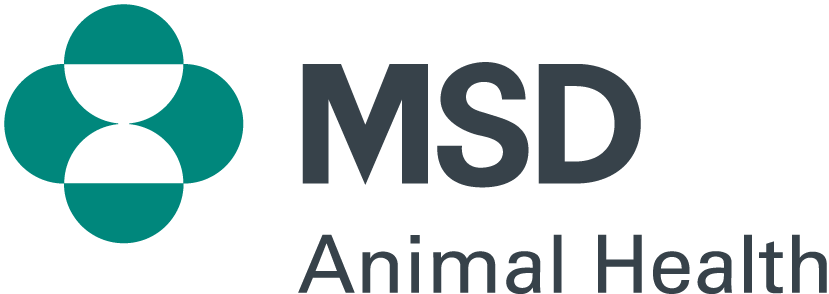

Nutrition for Better Reproduction
Optimal nutrition is essential for good immune health and function.
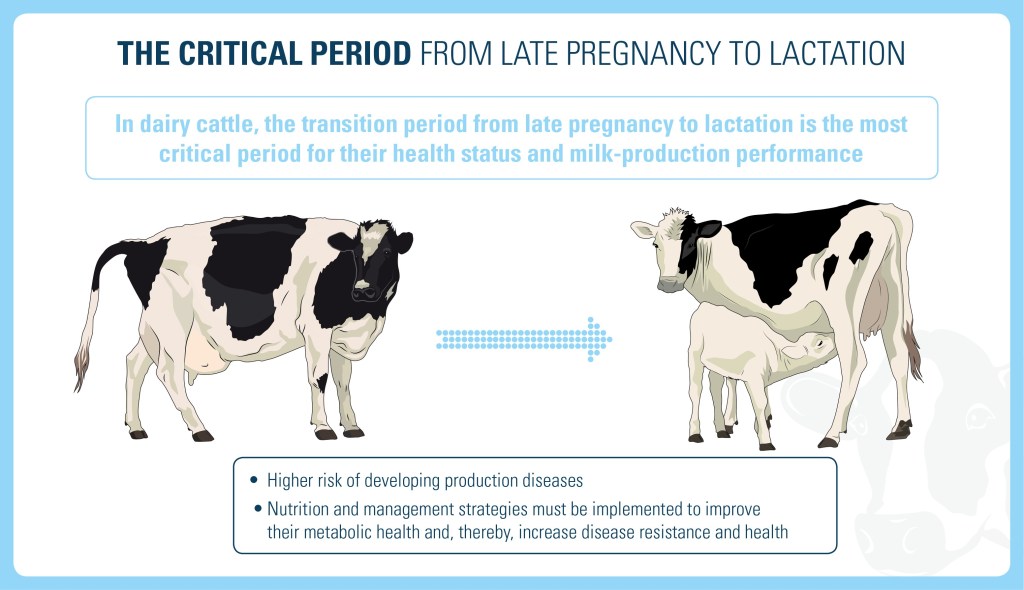
Nutrition has a major effect on cattle immune status. A state of physiological imbalance, or a negative energy balance (NEB), contributes to immunosuppression and, therefore, to an increased risk of developing reproductive diseases and of decreased fertility.
Around the time of calving, feed intake influences the energy status and immune function of dairy cows.
Factors influencing cow feed consumption:
- Diseases in early lactation
- Uncomfortable conditions, an inadequate feeding space and other management factors
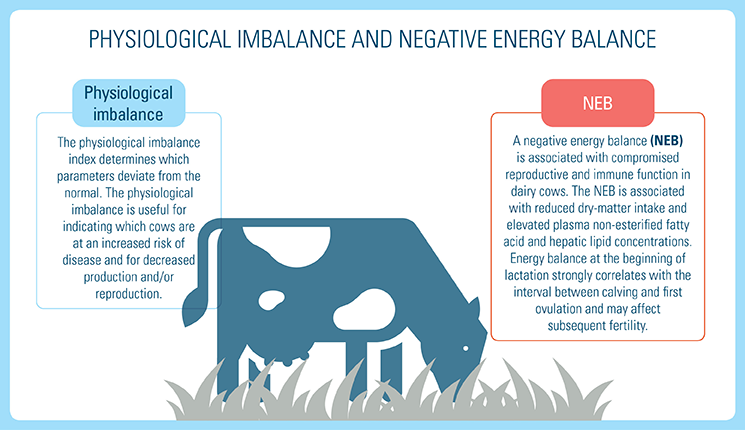
The nutrient requirements of dairy cows increase during early lactation, at the time when their feed intake remains relatively low.
Fresh lactating cows do not consume enough feed to meet their increased nutrient requirements during peak lactation, which can result in excessive mobilization of fat tissues, amino acids, minerals and vitamins to compensate.
Many studies have correlated nutritional imbalances with decreased fertility, although other reproductive management factors are also involved1.
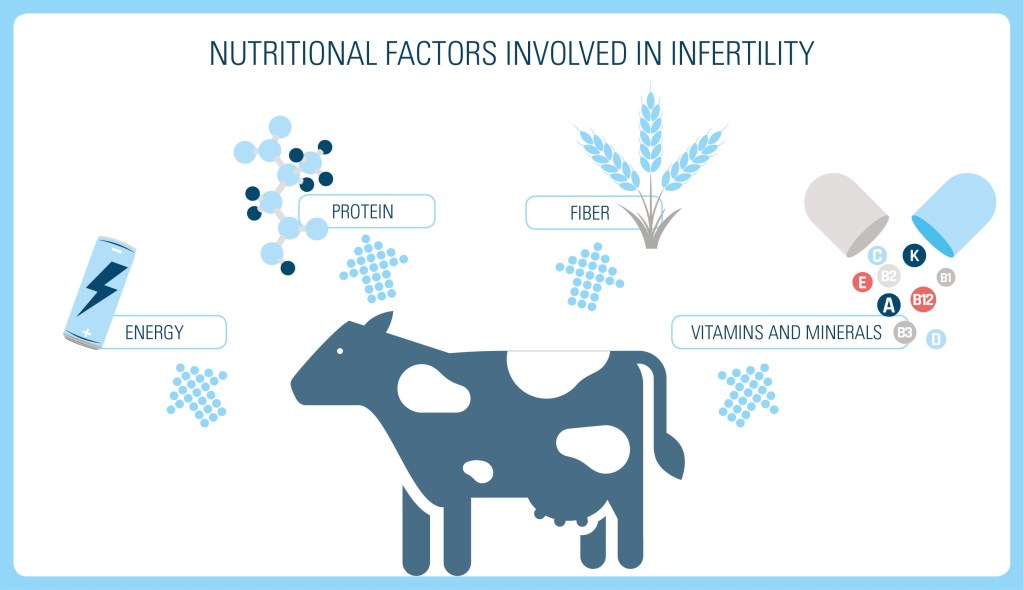
Body Condition Score
Cows with the poorest body condition in the first 65 days postpartum are most likely to be anovular at the end of the voluntary waiting period, have fewer pregnancies per artificial insemination and have an increased risk of pregnancy loss after the first artificial insemination postpartum2.
Energy Deficiency
The extent of the early postpartum negative energy balance (NEB) can delay the timing of the first ovulation, return to cyclicity and oocyte quality. NEB delays the time of first ovulation through inhibition of luteinizing hormone pulse frequency and low levels of blood glucose, insulin and insulin-like growth factor-I (IGF-I) that collectively restrain estrogen production by dominant follicles. NEB also reduces serum progesterone concentrations and fertility3.
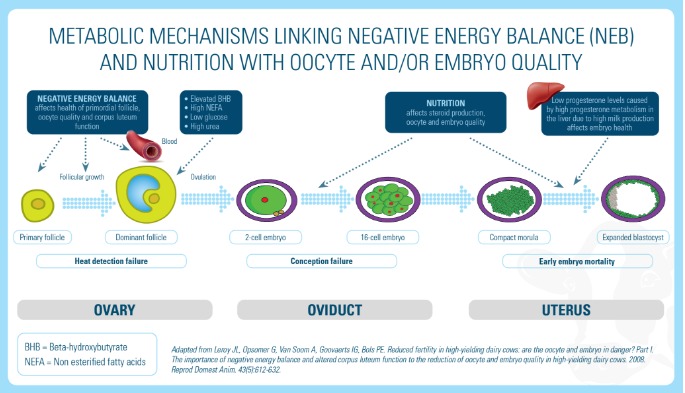
For optimum fertility, heifers should be gaining weight for 30 days before and after breeding4.
For optimal reproduction performance, cows must be in a good physical condition at calving (3.25-3.5).
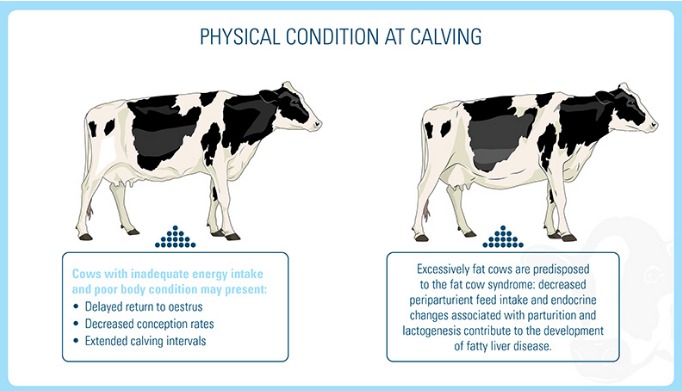
Protein Deficiency
Too little protein reduces dairy cows’ reproductive efficiency, delays the onset of puberty in heifers and increases the number of open days in cows.
Adequate protein is required for normal fetal development and proper reproductive organ function. In lactating cows, protein deficiency may result in decreased appetite, emaciation and low milk production5.
Excess Protein in Diets
When feeding pregnant dairy cows, excess protein content can also have a negative effect on reproductive parameters. Several studies have shown that increased dietary protein increases both the number of open days and the number of services required per conception5.
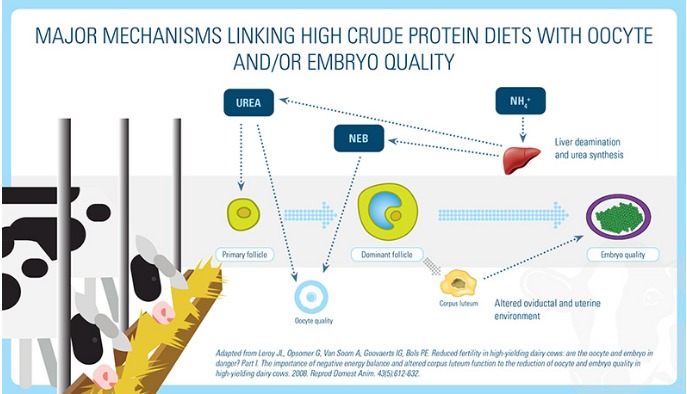
Urea
High urea intake can increase the incidence of abortion at first pregnancy, retained placenta at second calving and widen the calving intervals5.
For lactating dairy cows, each ration should contain between 14-18% protein, depending on their production level6.
Low-Roughage Diets
The reproductive performance in high-producing cows seems to decline when their roughage intake is less than 30% of the total dry matter ration1.
Vitamin and Mineral Deficiencies
Infertility in dairy cattle is frequently attributed to vitamin and mineral imbalances1.
Nutritional and health programs that meet cows’ needs should be implemented to favor their metabolic health and, thus, their reproduction7.
Feeding Strategies
Minimizing the severity and duration of negative nutrient balance is essential for improving cow health and welfare and for reducing economic losses.
- Rations should be balanced for their energy, protein, vitamin and mineral content in order to meet the nutrient requirements of cows near calving and during early lactation.
- Avoiding over-conditioning during the dry period helps reduce the risk of disease during early lactation. A body condition score of 3.25 at calving has been shown to be optimal for supporting the energy requirements of cows and for maintenance, parturition and lactation8.
- Several studies have shown that days to pregnancy are decreased (by 10 days) by controlling energy intake to near requirements of cows before calving compared with allowing cows to over-consume energy8.
Housing and Management Strategies
Optimizing the care and wellbeing of dairy cattle is also important to reduce productivity losses.
Groups of animals over 6 months of age may be organized differently based on variations in herd size and calving frequency. Feeding requirements, management needs, and especially size and age variation among animals in the same group must be considered9.
Regarding feeding space, it has been shown that not enough feed space may result in slow growth rates. Based on growth responses and feeding behavior, heifers that grow rapidly and that are fed a high quality total mixed diet in a free stall or a bedded pack group housing system require 15, 31 and 47 cm feed bunk lengths at 4-8, 11.5-15.5 and 17-21 months of age, respectively10.
Increasing the feeding space per cow also leads to diminished aggressive social interactions among cows and, ultimately, increased feeding activity11.
Studies comparing the feeding behavior of low-status and dominant cows recommend that space allowance should be at least 0.6 m per cow to accommodate the needs of all cows and to increase the motivation of low-ranking cows to access fresh feed, which could improve their nutritional status12.
- Moellers, J., Riese, R. 1988. “Nutritional Causes of Infertility in Dairy Cows,” Iowa State University Veterinarian: Vol. 50 : Iss. 2 , Article 5.
- Weaver, L.D. Effects. of Nutrition on Reproduction in Dairy Cows. The Veterinary Clinics o/North America. Nov. 1987. 513-532.
- Butler, W.R. 2003. Energy balance relationships with follicular development, ovulation and fertility in postpartum dairy cows. Livest. Prod. Sci. 83:211-218.).
- Morrow, D.A. 1980. The Role of Nutrition in Dairy Cattle Reproduction. Current Therapy in Theriogenology. WB Saunders Compnay. 449-455.
- Jordan, E.R., Swanson, L.V. 1979. Effect of Crude Protein on Reproductive Efficiency, Serum Total Protein and Albumin in the High Producing Dairy Cow. j. Dairy Sci. 62:58-63.
- Otterby, D.E., Linn, J.G. Effects of Nutrition on Reproduction in Dairy Cattle. Compo Cont. Ed. Vol. 5, No.2, Feb. 1983. S85-593.
- Santos, J.E.P., Bisinotto, R.S., Ribeiro, E.S., Lima, F.S., Thatcher, W.W. Impacts of metabolism and nutrition during the transition period on fertility of dairy cows. 2012 High Plains Dairy Conference.
- Drackley, J.K., Cardoso, F.C. 2014. Prepartum and postpartum nutritional management to optimize fertility in high-yielding dairy cows in confined TMR systems. Animal, 8 (1): 5-14.
- Graves, R.E., Tyson, J.T., McFarland, D.F., Wilson, T.H. 2008. Penn State Housing Plans for Calves and Heifers, NRAES‐201. Page 278.
- Longenbach, J.I., Heinrichs, A.J., Graves, R.E. Feed bunk length requirements for Holstein Dairy Heifers. 1999. Journal of Dairy Science 82(1):99-109,
- DeVries, T.J., et al. 2004. Effect of Feeding Space on the Inter-Cow Distance, Aggression, and Feeding Behaviour of Free-Stall Housed Lactating Dairy Cows. Journal of Dairy Science 87(5): 1432-1438
- Rioja-Lang, F.C., Roberts, D.J., Healy, S.D., Lawrence, A.B., Haskell, M.J. 2012. Dairy cow feeding space requirements assessed in a Y-maze choice test. Journal of Dairy Science 95:3954-3960.

